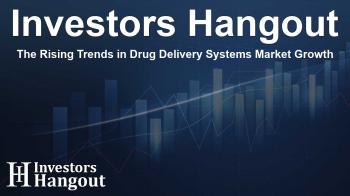The Rising Trends in Drug Delivery Systems Market Growth

The Drug Delivery Systems Market: A Growing Landscape
In today's healthcare environment, the importance of effective drug delivery systems cannot be overstated. The global drug delivery systems market was valued at approximately USD 43.91 billion recently and is poised to significantly increase to USD 68.86 billion in the coming years. This growth presents a robust compound annual growth rate (CAGR) of around 5.86% from 2025 to 2032, reflecting a surge driven by innovations and rising chronic disease prevalence.
Understanding the Market Dynamics
A key factor contributing to this market expansion is the increasing number of chronic illnesses affecting populations worldwide. Continuous advancements in technology are not only enhancing the therapeutic effectiveness of treatments but are also improving patient compliance. More sophisticated drug delivery technologies provide more precise solutions, allowing patients the convenience of self-administration. This has made it imperative for healthcare systems to adapt and evolve.
Drivers of Growth in Drug Delivery
The drug delivery systems market is seeing a remarkable transformation, influenced by various factors. One primary driver is the significant investment in healthcare infrastructure. In both developed and emerging markets, companies are heavily investing in drug delivery technologies, making them more accessible and effective. Additionally, regulatory environments are becoming increasingly supportive, enabling faster adoption of these advanced systems.
Insights from the U.S. Market
The United States stands out as a remarkable contributor, with its market size expected to grow from USD 14.84 billion to USD 22.89 billion. This upward trajectory is propelled by a solid healthcare infrastructure, a strong regulatory framework, and a conducive environment for research and development (R&D). Furthermore, the presence of leading pharmaceutical and medical device manufacturers in the country continues to fortify its market dominance.
Product Segmentation Trends
Within the market, injectables lead the charge, capturing an impressive 58.14% market share. Their importance is particularly pronounced in hospital settings where rapid intervention is crucial. Innovations like auto-injectors and prefilled syringes have greatly enhanced convenience and adherence to treatment regimens.
Market Segmentation: Devices and Channels
The traditional drug delivery devices, such as oral tablets, capsules, and syringes, command a substantial share due to their ease of use and lower production costs. Notably, retail pharmacies are projected to experience the highest growth during the forecast period, driven by an increasing trend towards self-treatment options for conditions like diabetes and asthma, coupled with the rise of e-pharmacies and digital health platforms.
Regional Growth Prospects
In a global context, North America maintains a commanding position due to its early technology adoption and comprehensive insurance coverage for drug delivery systems. Meanwhile, Asia-Pacific is emerging rapidly, with countries like China and India investing heavily in healthcare advancements and infrastructure. The increasing population of patients alongside the development of biosimilars presents promising growth opportunities in this region.
Key Players in the Market
It's important to note the competitive landscape is diverse, featuring major players including Johnson & Johnson, Pfizer, and Becton Dickinson, among others. These companies play crucial roles in the development of innovative drug delivery solutions, shaping the future of the market.
Conclusion
As we look ahead, the drug delivery systems market is not just expanding; it’s evolving with the needs of healthcare systems and patients alike. The blend of technological innovation, regulatory support, and the dynamic needs driven by chronic disease management ensures that this market will continue to play a vital role in global health initiatives. Stakeholders can be optimistic about the future as we navigate this transformative period in healthcare delivery.
Frequently Asked Questions
What is the projected market size of drug delivery systems by 2032?
The drug delivery systems market is projected to reach USD 68.86 billion by 2032.
Which region leads the drug delivery systems market?
North America is currently the leading region in the drug delivery systems market due to its established healthcare infrastructure.
What segment of drug delivery shows the highest market share?
Injectables hold the highest market share, accounting for 58.14% recently.
How are retail pharmacies impacting the drug delivery market?
Retail pharmacies are expected to experience significant growth due to increasing self-treatment demands among consumers.
What is the expected CAGR for the drug delivery systems market?
The expected CAGR is approximately 5.86% from 2025 to 2032.
About The Author
Contact Olivia Taylor privately here. Or send an email with ATTN: Olivia Taylor as the subject to contact@investorshangout.com.
About Investors Hangout
Investors Hangout is a leading online stock forum for financial discussion and learning, offering a wide range of free tools and resources. It draws in traders of all levels, who exchange market knowledge, investigate trading tactics, and keep an eye on industry developments in real time. Featuring financial articles, stock message boards, quotes, charts, company profiles, and live news updates. Through cooperative learning and a wealth of informational resources, it helps users from novices creating their first portfolios to experts honing their techniques. Join Investors Hangout today: https://investorshangout.com/
The content of this article is based on factual, publicly available information and does not represent legal, financial, or investment advice. Investors Hangout does not offer financial advice, and the author is not a licensed financial advisor. Consult a qualified advisor before making any financial or investment decisions based on this article. This article should not be considered advice to purchase, sell, or hold any securities or other investments. If any of the material provided here is inaccurate, please contact us for corrections.

